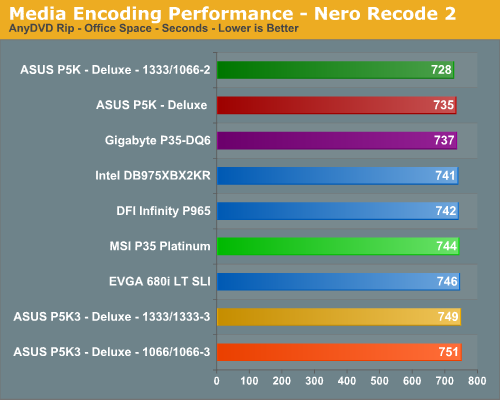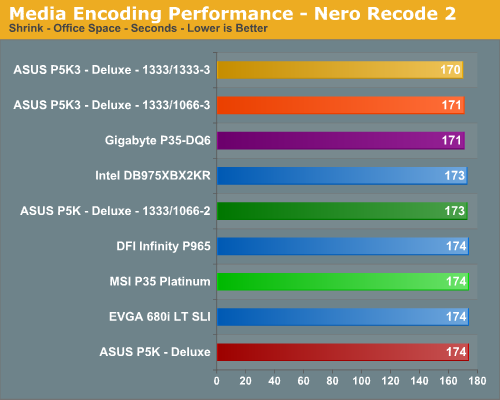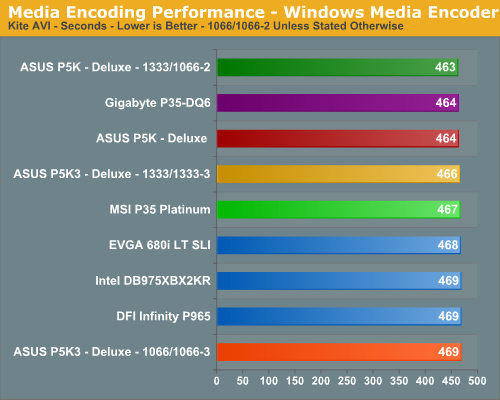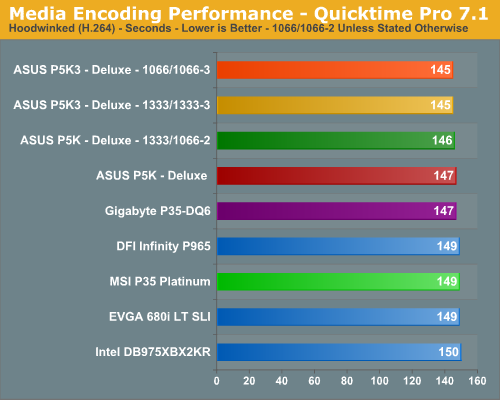Intel P35: Intel's Mainstream Chipset Grows Up
by Gary Key & Wesley Fink on May 21, 2007 3:45 PM EST- Posted in
- CPUs
Media Encoding Performance
We are utilizing an updated video encoding test suite for this article that includes AnyDVD, Nero Recode 2, Windows Media Encoder 9, and QuickTime Pro 7.1.Our first series of tests is quite easy - we take our original Office Space DVD and use AnyDVD and Nero Recode 2 to copy the full DVD to the hard drive without compression, thus providing an almost exact duplicate of the DVD. We then fired up Nero Recode 2, selected our Office Space copy on the hard drive, and performed a shrink operation to allow the entire movie along with extras to fit on a single 4.5GB DVD disc. We then go back and use Nero Recode to shrink the full DVD copy and burn it onto our DVD disc. We left all options on their defaults except we checked off the advanced analysis option. The scores reported include the full encoding process and is represented in minutes/seconds, with lower numbers providing better performance.


The AnyDVD Rip results are very interesting as we did not expect our DDR3 boards to perform in this manner when compared to the DDR2 boards, especially against the same chipset. Even though latencies are higher, the increased bandwidth would normally bring the DDR3 board within range of the DDR2 boards in a test that is CPU and disk intensive. The 3% performance deficit was unusual to say the least. The Shrink results are more in alignment showing a 2% difference between the boards, although for the first time we see the P5K Deluxe board falter a little at stock settings. We noticed at the beginning of the test there was always a brief stutter with this board. The change to 1333FSB really does not improve the scores.
Our next test has us converting our day at the beach AVI file into a high definition WMV file suitable for our Aunt Gertrude to view on her new high definition LCD TV. We ensured our quality settings were set to High Definition. The balance of options is set to standard settings and then we let this program do its magic. We are reporting the numbers in seconds to complete the conversion.

We see the boards with the best overall memory and latency performance once again leading in a test that is both CPU and memory sensitive. The difference is only a rather small 1.3% between the fastest and slowest scores, however.
Next on the list is our QuickTime Pro 7.1 test that will convert our newly downloaded .MOV file into a plasma screen pleasing H264 format. We ensured our quality settings were set to their highest levels and then let the horses loose. The values reported are in minutes/seconds for the conversion time, with lower numbers being better.

Once again, the 1333 platforms have a slight advantage in this test although the differences are minimal. Outside of the MSI board, all of the P35 boards are scoring slightly faster than the older chipsets, and the total range of scores differs by 3.5%.










58 Comments
View All Comments
Wesley Fink - Monday, May 21, 2007 - link
Early boards will be expensive, just like always. The prices will likely drop to the same levels as current P965 boards they replace, with a broad range for P35 boards from basic to "Asus Commando" level gaming boards. It is too early to be discouraged.Comdrpopnfresh - Tuesday, May 22, 2007 - link
I'm willing to bet we'll see them replacing the older boards quickly too. If intel and other manufacturers really want DDR3 to go through, you'll see DDR2 boards disappearing quickly. Its like what happened to s939. Basically the same chips were used for AM2, but the boards and chips quickly dried up and disappeared. The same can be said or PCI-e. In the beginning there wasn't much of a real world benefit, just the theoretical bandwidth increase. Because developments in AGP ceased, we might never know if the switch was necessary.Comdrpopnfresh - Monday, May 21, 2007 - link
If something other than NAND flash could be used, it would be very interesting to see a pci-e 1x board that can house DDR2 memory for use in turbo memory. That way, when people upgrade their ~35 boards to DDR3 when performance and price changes, the DDR2 can be used further. This would make a lot of sense too, because unlike Gigabyte's i-RAM device and logical ramdrives, the high speed, low latency properties of RAM could be used for turbo memory as a way around the 8gb limit of RAM on these cards. And since they are not used for storage, merely access, no redundancy on power supply is needed as with the i-RAM. Someone should start development on this...Comdrpopnfresh - Monday, May 21, 2007 - link
Why would the TDP on the P35 higher if it has no integrated video? Will third-party manufactures implement their own SLI into the P35 given that the reference model only had on x16 pci-e slot? Also, when can we expect to see pci-e2 and more than 4 dimm slots on intel mobos?yacoub - Monday, May 21, 2007 - link
Including a jumper to change the strap setting for the fsb is a nice feature on the MSi board. A little disappointed in the memory comparison test that that board had the lowest bandwidth and most latency. Is that something BIOS updates can improve or is that generally hardware (i.e. board design related)?Gary Key - Monday, May 21, 2007 - link
It is all BIOS tuning in regards to the MSI board. Our first results with the board had the memory performance being equal to the 945P boards. Two BIOS releases later and the improvements have been remarkable. I think MSI is about two BIOS spins behind ASUS and Gigabyte now. Gigabyte finally caught up but ASUS still has the better feature set and options in my opinion.michal1980 - Monday, May 21, 2007 - link
hardocp, seems to take a 180 different outlook on these boards. so werid.skaterdude - Monday, May 21, 2007 - link
What's so weird? Kyle is an extension of AMD's marketing department. He has not cared for Intel in a very long time, at least since he was caught cheating on some Intel benchmarks and was hung out to dry for it. Personally, it is alright to have a favorite company to root for but to do so in such an open and bias way is wrong if you are not running a company specific website. I would not have an issue at all if it was called HardAMD, at least you know what you are viewing is not tainted by free trips, booze, products, and general hostility against a company.
Back on subject....The P35 is a nice upgrade and it may not set the world on fire but it appears Intel listened and improved on a chipset they could have let ride for a lot longer. DDR3 will be interesting and at least the kinks will be worked out by the time X38 and the new processors get here. If I had not already bought a 965 board then P35 would have been the one. I am still miffed about not having a native IDE port as JMicron just plain sucks most of the time.
strikeback03 - Tuesday, May 22, 2007 - link
the P35 does not have native IDE either, and why use an IDE drive anyway?Spoelie - Monday, May 21, 2007 - link
ahum, AMD biased? After reading some of their recent gpu reviews, I thought it was the other way around... Check yourselfanyway, not a worthy upgrade, but a worthy new board. Which is what you could reasonably expect.